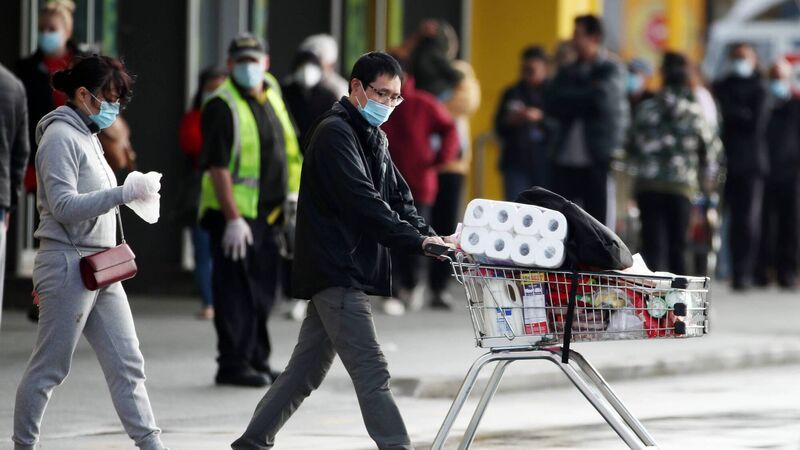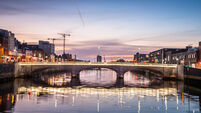Alison O’Connor: New Zealand offers a glimpse of our future living with Covid-19

As Ireland prepares to introduce its new Covid-19 alert system, New Zealand provides a good example of the localised approach, applying higher levels of restrictions to areas with higher rates of infection, such as Auckland. Picture: Fiona Goodall/Getty Images
More than one million children are back at school, the Leaving Certificate results are out, owners of 'wet pubs' have finally been given the nod on reopening. Under any other circumstances, you might feel we have some cause for celebration. Instead, the horrible undercurrent of Covid-19 dread we’ve all been living with feels all the more intense, with a degree of aimlessness thrown in.
What’s my motivation here, you want to ask, like a Hollywood actor ruminating on which direction their character needs to be brought. I know we’re trying to suppress the virus, but are we to stay at home? Or go to the pub? Since I live in Dublin, I’m to make a special effort not to have too many people in the house — but what about going out? Should I welcome universities re-opening or hope they all stick with distance learning? How can I work out in my head if I’m under-cautious or overly so?
Which expert or politician am I agreeing with today — or indeed even for a portion of today — given that there are not just variations in what they are all saying, but often downright contradictions. Remind me what it is the Government has asked us to do, exactly? Which is the official advice, and where did I read that NPHET actually called for a clampdown in a certain area but the Government overruled it? Does the television quiz still exist? If it does, surely someone could appear as a contestant with their chosen subject being Covid-19 restrictions.
Then we will see the cycle of hospital and ICU admissions rise. The way this virus works, it is impossible for there to be any other outcome in such a scenario.
It’s impossible not to feel terribly sorry for pub owners or empathise with how they feel victimised in all of this. However, as you watch the numbers rise each day, especially in Dublin and Limerick, it feels like playing with fire to allow them to open their doors. No matter how benignly the picture is painted, the combination of Irish people and the pub can be a lethal one, even outside of a pandemic.
However, some semblance of life has to go on, doesn’t it?
This argument holds validity in a commercial sense. If the Government sees danger and tries to keep things closed or impose more restrictions they are accused of being overreactive. By the time the realisation hits that there really is trouble in a health sense, it can be too late.

Next week, the Government is due to launch a Covid-19 alert system as part of the Government’s medium-term plan for recovery and resilience, which Micheál Martin described as a framework for how people live their lives with Covid-19. It will try to protect lives and livelihoods. Or, as recently described by James Stock, a Harvard economics professor, “how to suppress the virus as cost-effectively as possible”. If ever a public needed a plan it is the Irish public.
This plan will allow for more localised approaches to be taken. A very good example of such an approach has been in place in New Zealand since March. It is a four-level alert system which lists the measures to be taken against Covid-19 at each level.
Currently, for instance, that country is at Level 2, although Auckland has extra restrictions. Elsewhere, social gatherings can be held with up to 100 people in a defined space (that is, a single indoor or outdoor space separated from other spaces). You can have guests to your home, but the 100-person limit applies. However, in the Auckland region, a social gathering must not exceed 10 people in a defined space at any one time. You can have 10 people in your home, and that includes people who usually live in your house.
Public facilities, such as swimming pools and gyms, libraries and museums, can operate at Alert Level 2. If you can safely maintain 1m physical distance, there is no limit on how many people may safely be inside. If you go to a public facility, you legally must stay 1m apart from people you don't know, where possible — if you can not, consider wearing a face covering.
At Alert Level 1, people do not, for instance, need to wear face coverings because there is no evidence of community transmission. Compare this to their highest alert, Level 4, where the plan states “likely the disease is not contained” with sustained and intensive community transmission occurring, and widespread outbreaks.
In such an instance, people are instructed to stay at home in their bubble other than for essential personal movement. Safe recreational activity is allowed in local areas, but travel is severely limited. All gatherings are cancelled, and all public venues closed. Businesses are closed except for essential services. Schools and colleges are closed, supplies are rationed, facilities may be requisitioned, and healthcare services may be reprioritised.
There is considerable detail released. One of the recent daily posts on social media platforms such as Twitter and Facebook read as follows.
COVID-19 Update
— Unite against COVID-19 (@covid19nz) September 9, 2020
Today there are 6 new cases of COVID-19 in the community. They are all linked to the Mt Roskill Evangelical Fellowship Church group. 4 of the new cases are part of a smaller cluster - a group of 14 that are associated with a series of bereavement activities.
“Today there are 6 new cases of Covid-19 in the community. They are all linked to the Mt Roskill Evangelical Fellowship Church group. 4 of the new cases are part of a smaller cluster - a group of 14 that are associated with a series of bereavement activities.”
Another one caused a definite gulp once you’d read it: “The investigation case of the maintenance worker at the Rydges Hotel who had tested positive has now closed. The most likely source of infection was a one-off event from surface transmission in the hotel elevator.”
And finally: “There are now 74 people linked to the Auckland community cluster who remain in the Auckland Quarantine facility, that includes 58 people who have tested positive, as well as a number of household members.”
On on Tuesday night, Dr Colm Henry, the HSE’s chief clinical officer, said that we have learned about the virus since it came into our lives which means our approach to dealing with it can be more targeted.
“We won’t be reversing out the way that we drove in,” was how he put it.
To continue the motoring analogy, we can hope that after the launch of next week’s plan we can read the route map more easily.






